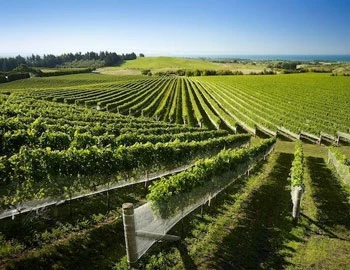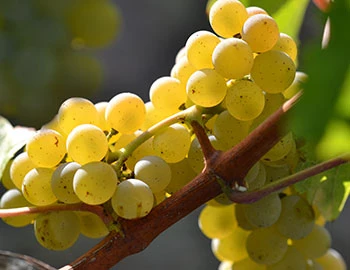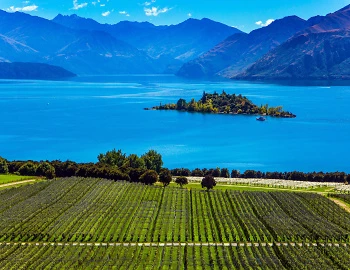The Supernatural Sauvignon Blanc 2018
Hawke's Bay, Supernatural Wine Co., 750 ml

| Grape variety: | Sauvignon Blanc |
| Producer: | Supernatural Wine Co. |
| Origin: | New Zealand / Hawkes Bay |
Description
An atypical, but all the more exciting representative of Sauvignon Blancs from New Zealand! Smoky and spicy at the same time, with aromas of tropical fruits, lemons, pink grapefruit and some honey. The fullness and texture come from the longer maceration period. Full-bodied and mineral on the palate with a long lasting finish.
Attributes
| Origin: | New Zealand / Hawkes Bay |
| Grape variety: | Sauvignon Blanc |
| Label: | Vegan, Certified organic or biodynamic wine |
| Ripening potential: | 1 to 8 years |
| Drinking temperature: | 10 to 12 °C |
| Food Pairing: | Sushi, Sashimi, Ceviche, Apéro riche, Grilled fish |
| Vinification: | short must fermentation, fermentation at low temperatures, fully destemmed |
| Harvest: | strict selection, selecting the grapes (by scanning) |
| Maturation: | on the yeast, short cultivation, bâtonnage |
| Maturation duration: | 6 months |
| Volume: | 13.5 % |
| Note: | Contains sulphites |
Supernatural Wine Co.
For the curious, the cosmopolitan, the devotees of organic and bio-dynamic principles, and most certainly for wine-fanatics: Our novelty from Hawke’s Bay in New Zealand is exceptional, exciting, and always leads to exhilarating discourse.
Just eight hectares of Sauvignon Blanc and a miniature vineyard of under a hectare of Pinot Gris – this is viticulturalist Hayden Penny’s demesne. The first tendrils were planted in 1989 on the Tuki Tuki Hills. In 2004, the Collinge family acquired the estate and planted new vines of Sauvignon Blanc and Pinot Gris. The northward vineyards are situated on hillsides with an incline of up to 30%. The calciferous loamy soil with volcanic influences (Green Glow) and sandy loamy soil sitting on a sandstone base (The Supernatural) produce inimitable wines full of character. The climate resembles that of Bordeaux, though a bit cooler overall.
The vineyard boasts an organic certification since 2015. Further advances revolve around bio-dynamic cultivation. The wines are vinified with as little interference as possible, fermented with indigenous yeasts, are barely or not filtered at all, and bottled with minimal amounts of sulphur. Green Glow and Spook Light are fermented on skins and maintained in contact with the lees for a couple of weeks – not unlike red wines, which explains their intense colour. The Pinot Gris, especially, glows in a beautiful red-and-gold shade.
The unconventional closure makes for another eyecatcher, as it is rarely used for wines. Some wine experts regard the crown cork as the superlative wine closure. And should the lights go out, you will have no troubles finding a bottle of Green Glow: it glows in the dark – for any eventualities.
Hawke’s Bay, situated on New Zealand’s northern island, embodies a paradise for spoilt palates, wine aficionados, and friends of nature. The vineyard is set in Millar Road, a wonderful place to spend a few relaxing days. Guests to the villas can expect any luxury conceivable, tastefully furnished surroundings, and a sublime view past the vineyards out onto the unending Pacific Ocean.

Supernatural Wine Co.
For the curious, the cosmopolitan, the devotees of organic and bio-dynamic principles, and most certainly for wine-fanatics: Our novelty from Hawke’s Bay in New Zealand is exceptional, exciting, and always leads to exhilarating discourse.
Just eight hectares of Sauvignon Blanc and a miniature vineyard of under a hectare of Pinot Gris – this is viticulturalist Hayden Penny’s demesne. The first tendrils were planted in 1989 on the Tuki Tuki Hills. In 2004, the Collinge family acquired the estate and planted new vines of Sauvignon Blanc and Pinot Gris. The northward vineyards are situated on hillsides with an incline of up to 30%. The calciferous loamy soil with volcanic influences (Green Glow) and sandy loamy soil sitting on a sandstone base (The Supernatural) produce inimitable wines full of character. The climate resembles that of Bordeaux, though a bit cooler overall.
The vineyard boasts an organic certification since 2015. Further advances revolve around bio-dynamic cultivation. The wines are vinified with as little interference as possible, fermented with indigenous yeasts, are barely or not filtered at all, and bottled with minimal amounts of sulphur. Green Glow and Spook Light are fermented on skins and maintained in contact with the lees for a couple of weeks – not unlike red wines, which explains their intense colour. The Pinot Gris, especially, glows in a beautiful red-and-gold shade.
The unconventional closure makes for another eyecatcher, as it is rarely used for wines. Some wine experts regard the crown cork as the superlative wine closure. And should the lights go out, you will have no troubles finding a bottle of Green Glow: it glows in the dark – for any eventualities.
Hawke’s Bay, situated on New Zealand’s northern island, embodies a paradise for spoilt palates, wine aficionados, and friends of nature. The vineyard is set in Millar Road, a wonderful place to spend a few relaxing days. Guests to the villas can expect any luxury conceivable, tastefully furnished surroundings, and a sublime view past the vineyards out onto the unending Pacific Ocean.

Sauvignon Blanc
The Sauvignon blanc can be recognized with your eyes closed. Its typical bouquet is marked by green notes: freshly cut grass, tomato bunches, gooseberry. Citrus fruits, cassis and flint join into the mix. In warmer latitudes it also shows exotic aromas, such as passion fruit. Its acidity is decidedly lively. In all likelihood, it comes from the Loire Valley, where it is vinified in Pouilly-Fumé and Sancerre in its purest form: varietally, and without timber. In the 18th century, it found its way to Bordeaux. Ambitious producers assemble it there with Sémillon into substantial whites, which are aged in oak barrels. The Sauvignon blanc has been a sensational success in the past 20 years in New Zealand. With its refreshing sweet-and-sour style, winemakers from down under have conquered the world. The rich Sauvignons from Styria and crisp examples of South Tyrol and Friuli are worth mentioning as well. It pairs with anything from the sea. Or do it like they do on the Loire, and enjoy it with goat cheese.

New Zealand
Kia Ora - Welcome to New Zealand!
In the southwestern Pacific Ocean, between Australia and New Caledonia, lies New Zealand, a stunningly beautiful country consisting of two main islands. This island state was first discovered at the end of the 13th century. Aotearoa, or the Land of the Long White Cloud: is what the indigenous people, the Maori, named it. The nation covers a length of some 1,500 km and lies between 34° and 47° southern latitude (compared to our location, this corresponds to Tunis and Paris) and is therefore the world’s southernmost winegrowing country. Its «immediate» neighbours are relatively distant: Australia to the west, Antarctica to the south, with New Caledonia, Tonga and Fiji to the north.



